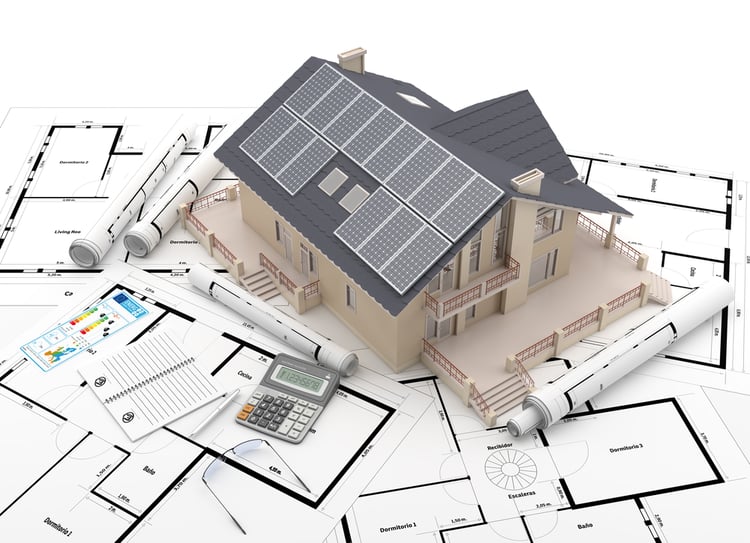Breaking Down the Price of Solar Power Systems

If you compare solar panel prices online, you will notice that their costs per watt are much lower than those quoted by installers. This can lead to the wrong idea that solar companies are making very high profits, but the truth is different. A solar energy system has multiple components, and photovoltaic modules are only one of them.
The National Renewable Energy Laboratory (NREL) publishes the annual US Solar Photovoltaic System and Energy Storage Cost Benchmark, and the latest edition became available in November 2021. The NREL provides a detailed breakdown of solar PV system costs by market segment: residential, commercial, and utility.
Get a professional solar PV system design for your building and reduce your power bills.
When comparing solar power projects, economies of scale are evident. As the size of solar projects increases, their cost per watt decreases significantly. This is reflected in the average prices from most recent NREL technical report:
|
Solar PV System Size |
Typical Cost |
|
7.15 kW Residential |
$2.65 / watt |
|
200 kW Rooftop Commercial |
$1.56 / watt |
|
500 kW Ground-Mounted Commercial |
$1.64 / watt |
|
100 MW Fixed Tilt Utility |
$0.83 / watt |
|
100 MW One-Axis Tracking Utility |
$0.89 / watt |
Note how the cost per watt is nearly 70% lower in utility-scale PV systems, compared with small residential systems. However, solar panels are financially viable at all project scales. Residential and commercial solar systems are analyzed based on electricity savings at retail prices, while utility-scale projects are analyzed based on electricity generation at wholesale prices. In other words, smaller systems have a higher cost per watt, but their economic benefit per kWh generated is also higher.
Solar PV System Prices: What Do They Include?

Photovoltaic panels are the most visible part of a solar energy system, but there are many other components at work. These include solar inverters, racking systems, wiring, circuit breakers, and monitoring systems. Depending on how your solar energy system is designed, it may include optional components like batteries and power optimizers.
The quoted price of a solar power system also includes soft costs that are not evident when looking at a completed installation: permitting, inspections, grid interconnection, taxes, transportation, land acquisition, design work, skilled labor, customer acquisition, overhead, profit margins, etc. To get a general and clear idea of how much do solar panels cost including the costs above which differ in each US state, it's advisable to get in touch with a professional solar installation company.
Solar panels only represent a fraction of system costs, and this has been analyzed by the NREL. The November 2021 technical report considers a PV module cost of $0.34 per watt, which is equivalent to:
- 12.8% of costs in a typical residential installation
- 21.8% in a rooftop commercial system
- 41.0% in a utility-scale system without solar tracking
As the size of a solar array increases, photovoltaic modules represent a higher percentage of total costs, while the percentage of soft costs decreases. This is also why large projects are more sensitive to solar module prices, and more dependent on low-cost imports from overseas.
Individual Cost of Solar PV System Components
The NREL report also breaks down solar PV system costs by item and by market segment. The following table summarizes their findings from the November 2021 report:
|
Solar Components and Soft Costs |
Residential Market Price Contribution |
Commercial Market Price Contribution |
Utility-Scale Market Price Contribution |
|
PV module |
$0.34/W |
$0.34/W |
$0.34/W |
|
Inverter |
$0.15/W single-phase string type $0.28/W string + power optimizers $0.31/W microinverter |
$0.08/W three-phase string type $0.16/W string + power optimizers $0.31/W microinverter |
$0.05/W |
|
Structural BOS (racking) |
$0.09/W |
$0.11/W - $0.18/W |
$0.09/W - $0.12/W |
|
Electrical BOS |
$0.19/W - $0.30/W |
$0.13/W - $0.45/W |
$0.07/W - $0.14/W |
|
Sales Tax |
5.1% national average |
5.1% national average |
5.1% national average |
|
PII* |
$0.21/W small installer $0.23/W national integrator |
$0.03/W - $0.12/W |
$0.02/W - $0.06/W |
|
Sales and marketing |
$0.42/W small installer $0.58/W national integrator |
N/A |
N/A |
|
Overhead |
$0.27/W small installer $0.28/W national integrator |
$0.27/W - $0.47/W developer overhead 13% of equipment EPC overhead |
2-12% developer overhead 8.67-13% material and equipment, 23-69% labor EPC overhead |
|
Typical profit |
17% |
7% |
5%-8% |
*NOTE: PII stands for permitting, inspection and interconnection.
As you can see in the table above, the price of a solar power system is the sum of many individual costs. The table considers the costs that tend to fall within a certain price range, but others are more variable - supply chain costs and skilled labor are two examples.

Michael Tobias
Michael Tobias, the Founding Principal of NY Engineers, currently leads a team of 150+ MEP/FP engineers and has led over 4,000 projects in the US
Join 15,000+ Fellow Architects and Contractors
Get expert engineering tips straight to your inbox. Subscribe to the NY Engineers Blog below.

